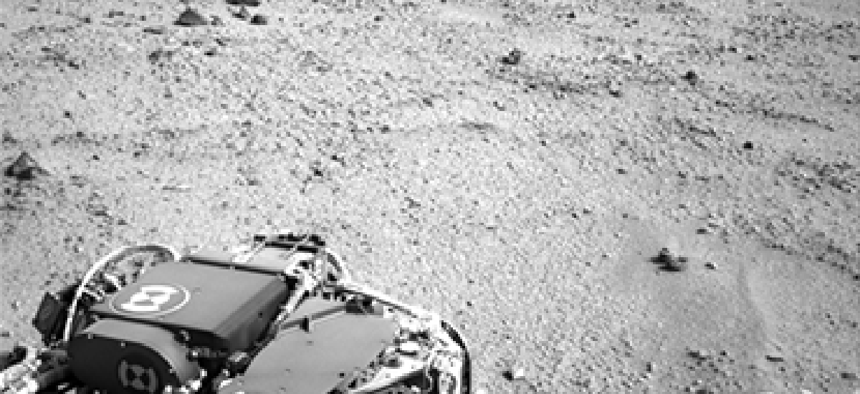On Mars, it's as if the shutdown never happened

NASA kept its rover Curiosity on course during the shutdown. Plus: NOAA assesses impact on satellite programs.

Curiosity chugs toward Mars' Mt. Sharp. (NASA photo)
On Mars, it's as if the government shutdown never happened. NASA's Mars rover, Curiosity, continued chugging toward a mountain on the Red Planet while Congress fought over conditions for a spending deal.
NASA staffed a skeleton crew of 550 out of its total 18,000 workforce during the shutdown, keeping Curiosity on its eight-kilometer trek to Mount Sharp. Moving at a maximum speed of 1.5 inches per second, Curiosity is sometimes able to cover 40 meters of ground per day. While it continued sending images back to NASA as it journeyed to its ultimate Martian destination, the rover's team was happy to reintroduce itself via its favorite means of public communication: Twitter.
Eager to be back after a nearly three-week social media hiatus, the Curiosity team linked to a picture of the 5.5-km Mount Sharp, which Curiosity could reach by the end of 2013.
"Allow me to reintroduce myself," the Curiosity team announced on Twitter to its 1.5 million followers. "I'm back on Twitter & even closer to Mars' Mount Sharp."
Fortunately for NASA, the shutdown does not appear to have delayed the launch of its next Mars probe, the Mars Atmosphere and Volatile Evolution (MAVEN) orbiter.
According to NASA officials, the $650 million mission remains on pace to launch Nov. 18 because NASA granted it a shutdown exemption. In addition to studying the Martian atmosphere, MAVEN is to act as a communications relay between NASA and the two rovers cruising around on the Red Planet: Curiosity and Opportunity. The orbiter NASA currently uses as a communications relay is more than a decade old.
Had it not been exempted, the shutdown could have caused MAVEN to miss its window, which closes Dec. 7. If that had happened, the next possible launch date for Maven would have been 2016 due to the positioning of Mars and Earth.
NOAA assessing shutdown impacts
Now back to full staff, the National Oceanic and Atmospheric Administration is sorting out whether the shutdown affected the development of its two largest satellite programs, the Joint Polar Satellite System and the Geostationary Operational Environmental Satellite-R (GOES-R) program.
Worth a collective $22 billion in estimated lifecycle costs, the satellite programs are vital to NOAA's mission of providing weather forecast data to scientists on the ground.
"Currently, NOAA is assessing the short and long-term impacts of the government shutdown to the development of, and launch schedules for, all the spacecraft in its satellite acquisition portfolio, particularly, GOES-R and JPSS," a NOAA spokesperson told FCW.
Both programs have experienced cost setbacks and launch delays in the past, and both received congressional attention in September after critical reports were released by the Government Accountability Office.
A team of experts from NOAA, NASA, the Department of Defense and international partners and contractors will complete an analysis of the impact of the shutdown to their costs and schedules over the next several weeks.






